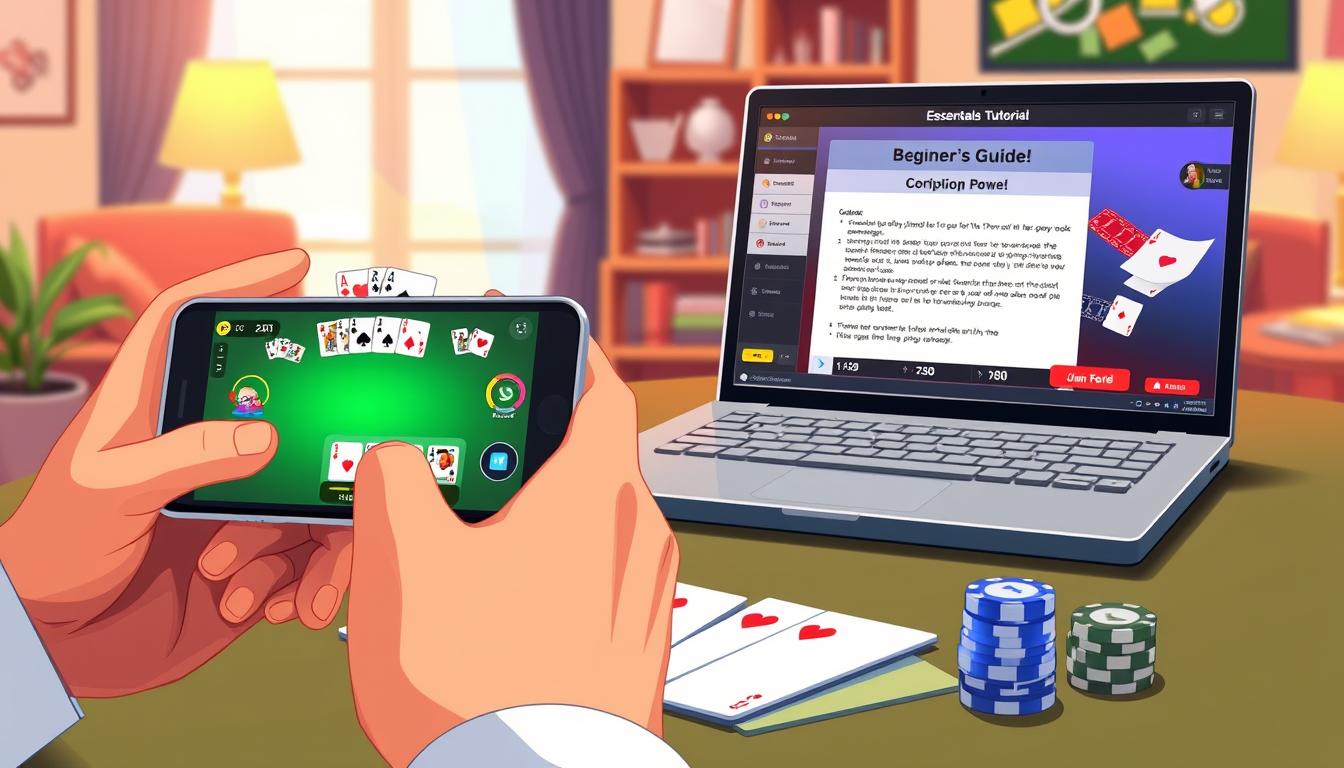Are you ready to master the game of poker from the comfort of your own home? With the rise of online gaming, it’s now easier than ever to learn and improve your poker skills.
Online poker offers a unique blend of strategy, skill, and excitement, making it a favorite among gamers worldwide. Whether you’re a complete beginner or looking to refine your techniques, our comprehensive guide will walk you through the basics and beyond.
As you embark on this journey, you’ll discover the benefits of playing online, from convenience and flexibility to a wider range of game options. Our guide is designed to help you navigate the online poker landscape with ease.
Key Takeaways
Table of Contents
- Understand the basics of online poker and its benefits.
- Learn how to choose the right online poker platform.
- Discover strategies to improve your poker skills.
- Explore the different types of online poker games.
- Find out how to manage your bankroll effectively.
Getting Started with Online Poker
The world of online poker is vast and accessible, but where do you begin? To start playing online poker, you’ll need to understand the basics, including the hardware and software requirements, the different types of games available, and how to set up your first account.
What You Need to Begin
To play online poker, you’ll need a few basic things: a computer or mobile device, a stable internet connection, and a compatible operating system. Most online poker sites are optimized for Windows and macOS, and many also offer mobile apps for Android and iOS devices. Additionally, you’ll need to create an account on an online poker platform, which typically requires providing some personal details and creating a username and password.
Understanding the Different Types of Online Poker
Online poker offers a variety of games, including Texas Hold’em, Omaha, and Seven-Card Stud. Texas Hold’em is the most popular variant, known for its strategic depth and exciting gameplay. Omaha is similar to Texas Hold’em but with a few key differences, such as dealing four cards to each player instead of two. Understanding the rules and strategies of each game is crucial for success.
Setting Up Your First Account
To set up your first account, choose a reputable online poker site that suits your needs. Look for sites with good bonuses, a user-friendly interface, and a variety of games. The sign-up process typically involves registering with your email address, creating a password, and providing some basic information. You’ll also need to make a deposit to start playing. Many sites offer a welcome bonus to new players, which can be a great way to boost your bankroll.
| Game Type | Description | Popularity |
|---|---|---|
| Texas Hold’em | The most popular poker variant, known for its strategic depth. | High |
| Omaha | Similar to Texas Hold’em, but with four cards dealt to each player. | Medium |
| Seven-Card Stud | A classic poker variant where players receive seven cards. | Low |
How to Play Poker Online: The Basics
As you begin your online poker journey, learning the basics will help you navigate the virtual tables with confidence. Mastering the fundamentals of online poker is essential for a enjoyable and potentially profitable experience.
Navigating Online Poker Platforms
Navigating online poker platforms can seem daunting at first, but understanding the layout and features can enhance your experience. The lobby is typically where you’ll find available games, tournaments, and other features. You can usually filter games by stakes, game type, and number of players. Familiarizing yourself with the platform’s interface will help you find the games you want quickly and efficiently.
Some key features to look for when navigating online poker platforms include:
- Game selection: Look for a variety of game types, including Texas Hold’em, Omaha, and Seven-Card Stud.
- Tournament schedules: Check the schedule for upcoming tournaments and their buy-ins.
- Promotions and bonuses: Many sites offer promotions and bonuses for new and existing players.
Understanding the Virtual Table Interface
The virtual table interface is where you’ll spend most of your time playing online poker. The interface typically includes features such as:
- Player seating and stack sizes
- Community cards and board texture
- Betting controls and pot size
- Chat box or other communication tools

Understanding these features is crucial for making informed decisions during play. Take some time to explore the interface and familiarize yourself with the different elements.
Managing Your Bankroll
Managing your bankroll effectively is critical to long-term success in online poker. This includes setting limits on your deposits and losses, as well as choosing the right stakes for your skill level. A general rule of thumb is to have at least 20-30 buy-ins for the stakes you’re playing. This will help you weather the variance and avoid going broke during a downswing.
By mastering the basics of online poker, including navigating the platform, understanding the virtual table interface, and managing your bankroll, you’ll be well on your way to developing a solid online poker strategy and improving your overall game.
Essential Poker Rules and Hand Rankings
To play poker effectively, it’s essential to grasp the basic rules and hand rankings. Understanding these fundamentals will enhance your gaming experience and improve your chances of winning.
Poker Hands Ranking Explained
Poker hand rankings are the backbone of the game, determining the winner in each round. The rankings, from highest to lowest, are:
- Royal Flush: Ace, King, Queen, Jack, and 10, all of the same suit.
- Straight Flush: Five cards in a row, all of the same suit.
- Four of a Kind: Four cards of the same rank.
- Full House: Three cards of one rank and two cards of another rank.
- Flush: Five cards of the same suit.
- Straight: Five cards in a row, but not all of the same suit.
- Three of a Kind: Three cards of the same rank.
- Two Pair: Two cards of one rank and two cards of another rank.
- One Pair: Two cards of the same rank.
- High Card: The highest card in your hand, if you don’t have any of the above hands.
Betting Structures and Game Flow
Betting structures and game flow are critical components of poker. The betting structure determines how much you can bet or raise during each round. Common structures include:
- Limit: Betting is capped at a certain amount.
- No Limit: You can bet any amount of chips you have.
- Pot Limit: You can bet up to the current size of the pot.
Understanding these structures and how they affect the game flow is vital. The game flow includes dealing cards, placing bets, and determining the winner. Familiarizing yourself with these aspects will make you a more confident player.
Choosing the Best Online Poker Sites
Navigating the multitude of online poker platforms can be overwhelming, but we’re here to guide you. With so many options available, it’s essential to choose a site that meets your needs and provides a secure environment for play.
Top Rated Poker Platforms for US Players
The US online poker market is served by several top-rated platforms. Sites like WSOP and PartyPoker are popular among players due to their user-friendly interfaces, generous bonuses, and varied tournament offerings. When selecting a site, consider the type of games you want to play and the level of competition you’re comfortable with.

Security and Fair Play Considerations
Ensuring the site you choose prioritizes security and fair play is crucial. Look for platforms that are licensed and regulated by reputable bodies, such as the UK Gambling Commission or the Pennsylvania Gaming Control Board. These sites use advanced encryption and regularly audited RNGs to ensure game integrity.
Deposit and Withdrawal Options
A good online poker site should offer a variety of deposit and withdrawal options to suit different banking needs. Major sites typically accept credit cards, e-wallets like PayPal, and bank transfers. Be sure to check the processing times and any associated fees before making a transaction.
Strategies for Success in Online Poker
The key to winning at online poker lies in understanding the game’s intricacies and adapting your strategy accordingly. To achieve this, players need to develop a multifaceted approach that includes understanding the basics, reading opponents, and navigating tournament structures effectively.
Beginner Strategies to Implement Immediately
For those new to online poker, starting with low stakes is a prudent strategy. This approach allows players to gain experience without risking significant amounts of money. Being selective with your starting hands is also crucial; focus on strong hands to maximize your chances of winning.
- Start with low-stakes games to minimize risk.
- Be selective with your starting hands.
- Observe your opponents’ playing styles.
Reading Virtual Tells and Player Patterns
In online poker, players can’t see each other’s physical reactions, but they can still identify patterns and “tells” through betting behavior and timing. Paying attention to how quickly opponents make decisions or the size of their bets can provide valuable insights into their hand strength.
Online Poker Tournament Strategies
Tournaments require a different set of strategies compared to cash games. Understanding the structure of the tournament and adjusting your play accordingly is vital.
Navigating Tournament Structures
Online poker tournaments come in various formats, including turbo, deep stack, and sit-and-go. Each format demands a tailored strategy, with factors like blind levels and stack sizes influencing your decisions.
Adjusting Your Play Throughout Tournaments
As tournaments progress, the dynamics change. Players need to adjust their strategy based on their stack size relative to the blinds and the aggression level of their opponents.
Common Mistakes to Avoid
Avoiding common pitfalls is as important as employing effective strategies. Common mistakes include playing too many hands, failing to adapt to table dynamics, and not managing your bankroll effectively.
Key mistakes to avoid:
- Playing too aggressively or passively.
- Not adjusting to changing table dynamics.
- Ignoring bankroll management.
By implementing these strategies and avoiding common mistakes, players can significantly improve their online poker game. Whether you’re a beginner or an experienced player, there’s always room to refine your approach and adapt to the ever-changing landscape of online poker.
Conclusion: Taking Your Online Poker Skills to the Next Level
Now that you’ve learned how to play poker online, it’s time to take your skills to the next level. By understanding the basics, navigating online poker platforms, and managing your bankroll, you’ve built a solid foundation for success.
To continue improving, explore the top online poker games, including cash games and tournaments. These games offer a range of challenges and opportunities to test your skills against other players.
As you progress, focus on developing strategies to read virtual tells and player patterns. This will help you make informed decisions at the table and increase your chances of winning. By combining these skills with a solid understanding of poker rules and hand rankings, you’ll be well on your way to becoming a skilled online poker player.
Keep practicing, and you’ll soon find yourself competing in the top online poker games, where you can put your skills to the test against the best players.
FAQ
What are the basic requirements to play online poker?
To play online poker, you’ll need a computer or mobile device with a stable internet connection, a supported operating system, and a compatible web browser or poker software.
How do I choose the best online poker site?
When choosing an online poker site, consider factors such as site reputation, game variety, bonuses, security, and customer support to ensure a safe and enjoyable experience.
What are the most popular types of online poker games?
The most popular types of online poker games include Texas Hold’em, Omaha, and Seven-Card Stud, with various tournament and cash game formats available.
How do I manage my bankroll effectively in online poker?
To manage your bankroll effectively, set a budget, choose the right stakes, and avoid playing at levels that exceed your means, ensuring you can weather variance and downswings.
What are some beginner strategies for online poker?
Beginner strategies for online poker include starting at low stakes, being selective with your starting hands, and observing your opponents to gain an edge.
How do I read virtual tells and player patterns in online poker?
To read virtual tells and player patterns, pay attention to betting behavior, timing, and other online-specific indicators that can reveal information about your opponents’ hands and playing styles.
What are some common mistakes to avoid in online poker?
Common mistakes to avoid in online poker include playing too many hands, failing to manage your bankroll, and not adapting to changing table dynamics and opponent strategies.
How do online poker tournaments work?
Online poker tournaments involve competing against other players for a share of the prize pool, with tournament structures, blind levels, and payout distributions varying depending on the specific event.
